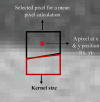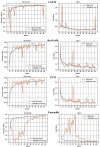Ensemble classification of integrated CT scan datasets in detecting COVID-19 using feature fusion from contourlet transform and CNN
- PMID: 37973820
- PMCID: PMC10654719
- DOI: 10.1038/s41598-023-47183-9
Ensemble classification of integrated CT scan datasets in detecting COVID-19 using feature fusion from contourlet transform and CNN
Abstract
The COVID-19 disease caused by coronavirus is constantly changing due to the emergence of different variants and thousands of people are dying every day worldwide. Early detection of this new form of pulmonary disease can reduce the mortality rate. In this paper, an automated method based on machine learning (ML) and deep learning (DL) has been developed to detect COVID-19 using computed tomography (CT) scan images extracted from three publicly available datasets (A total of 11,407 images; 7397 COVID-19 images and 4010 normal images). An unsupervised clustering approach that is a modified region-based clustering technique for segmenting COVID-19 CT scan image has been proposed. Furthermore, contourlet transform and convolution neural network (CNN) have been employed to extract features individually from the segmented CT scan images and to fuse them in one feature vector. Binary differential evolution (BDE) approach has been employed as a feature optimization technique to obtain comprehensible features from the fused feature vector. Finally, a ML/DL-based ensemble classifier considering bagging technique has been employed to detect COVID-19 from the CT images. A fivefold and generalization cross-validation techniques have been used for the validation purpose. Classification experiments have also been conducted with several pre-trained models (AlexNet, ResNet50, GoogleNet, VGG16, VGG19) and found that the ensemble classifier technique with fused feature has provided state-of-the-art performance with an accuracy of 99.98%.
© 2023. The Author(s).
Conflict of interest statement
The authors declare no competing interests.
Figures


















Similar articles
-
Using fused Contourlet transform and neural features to spot COVID19 infections in CT scan images.Intell Syst Appl. 2023 Feb;17:200182. doi: 10.1016/j.iswa.2023.200182. Epub 2023 Jan 13. Intell Syst Appl. 2023. PMID: 40478143 Free PMC article.
-
Computer aid screening of COVID-19 using X-ray and CT scan images: An inner comparison.J Xray Sci Technol. 2021;29(2):197-210. doi: 10.3233/XST-200784. J Xray Sci Technol. 2021. PMID: 33492267
-
A hybrid CNN and ensemble model for COVID-19 lung infection detection on chest CT scans.PLoS One. 2023 Mar 9;18(3):e0282608. doi: 10.1371/journal.pone.0282608. eCollection 2023. PLoS One. 2023. PMID: 36893081 Free PMC article.
-
Development and integration of VGG and dense transfer-learning systems supported with diverse lung images for discovery of the Coronavirus identity.Inform Med Unlocked. 2022;32:101004. doi: 10.1016/j.imu.2022.101004. Epub 2022 Jul 8. Inform Med Unlocked. 2022. PMID: 35822170 Free PMC article. Review.
-
COVID-19 diagnosis using state-of-the-art CNN architecture features and Bayesian Optimization.Comput Biol Med. 2022 Mar;142:105244. doi: 10.1016/j.compbiomed.2022.105244. Epub 2022 Jan 20. Comput Biol Med. 2022. PMID: 35077936 Free PMC article. Review.
References
MeSH terms
LinkOut - more resources
Full Text Sources
Medical

